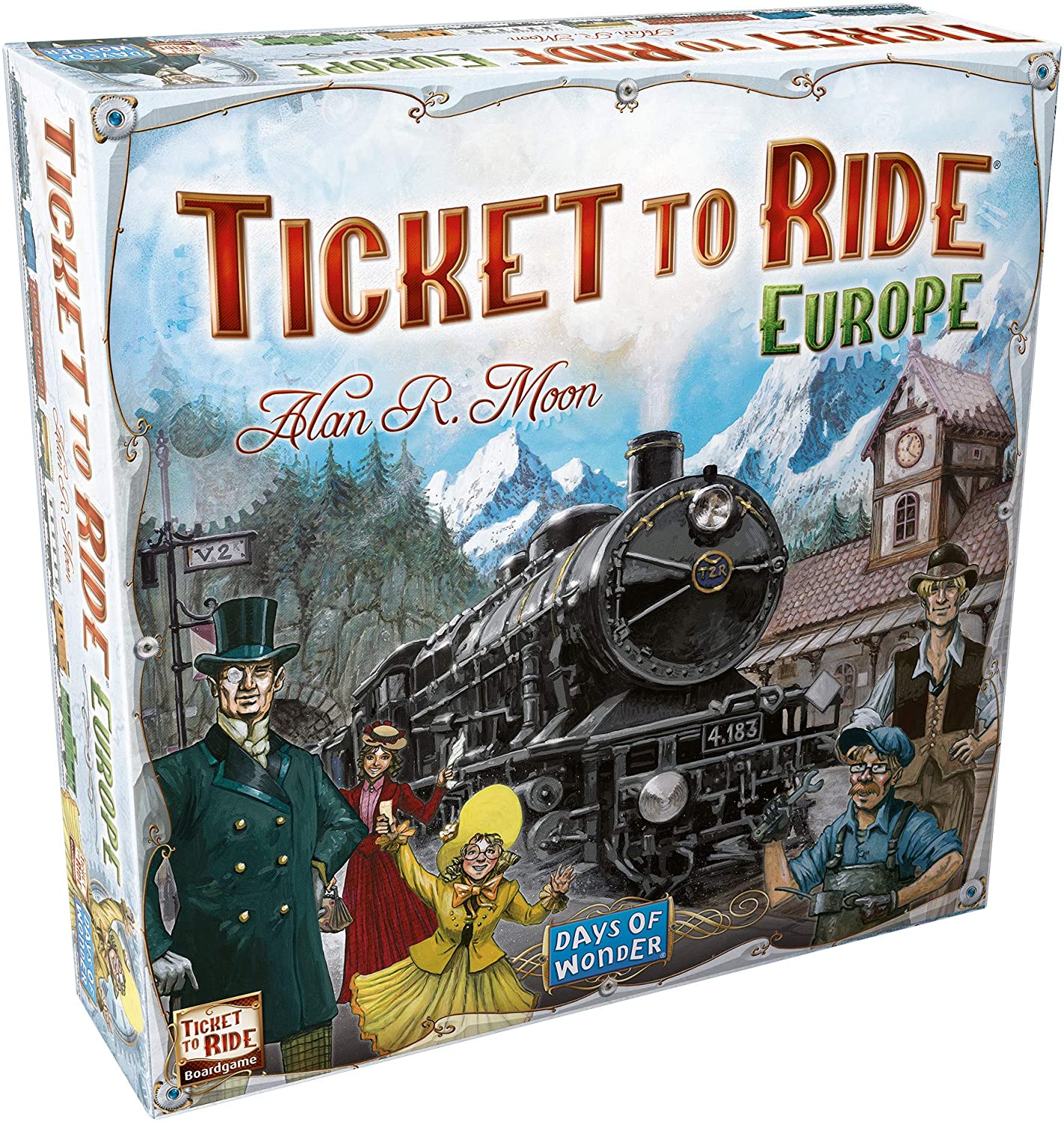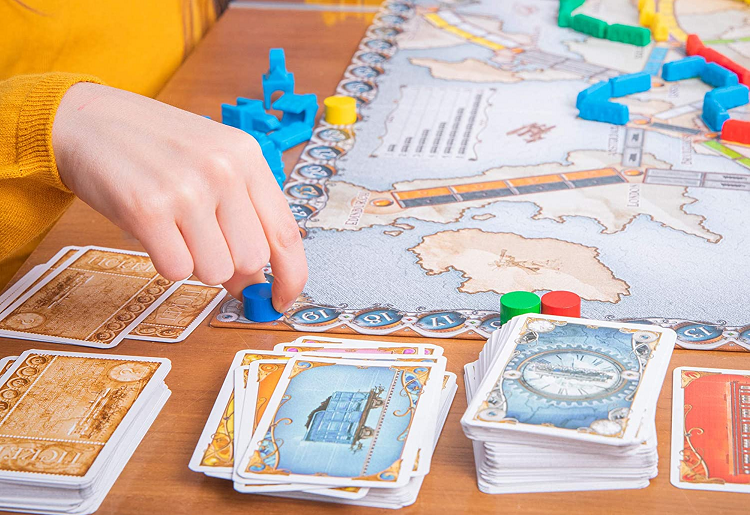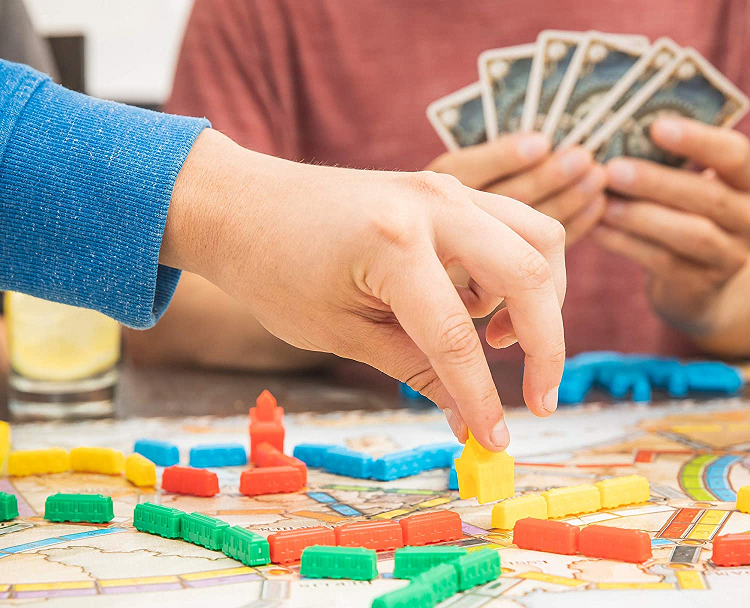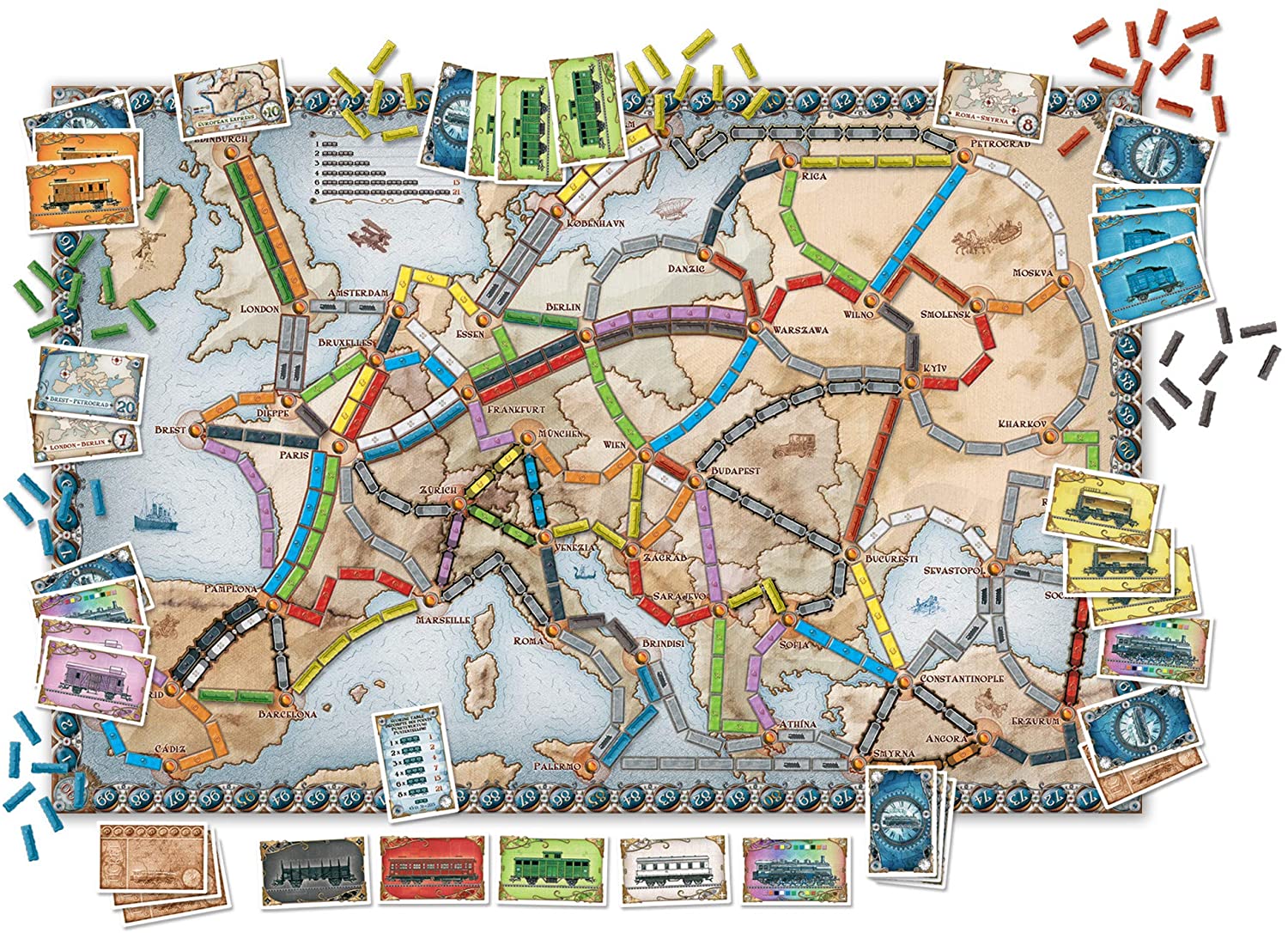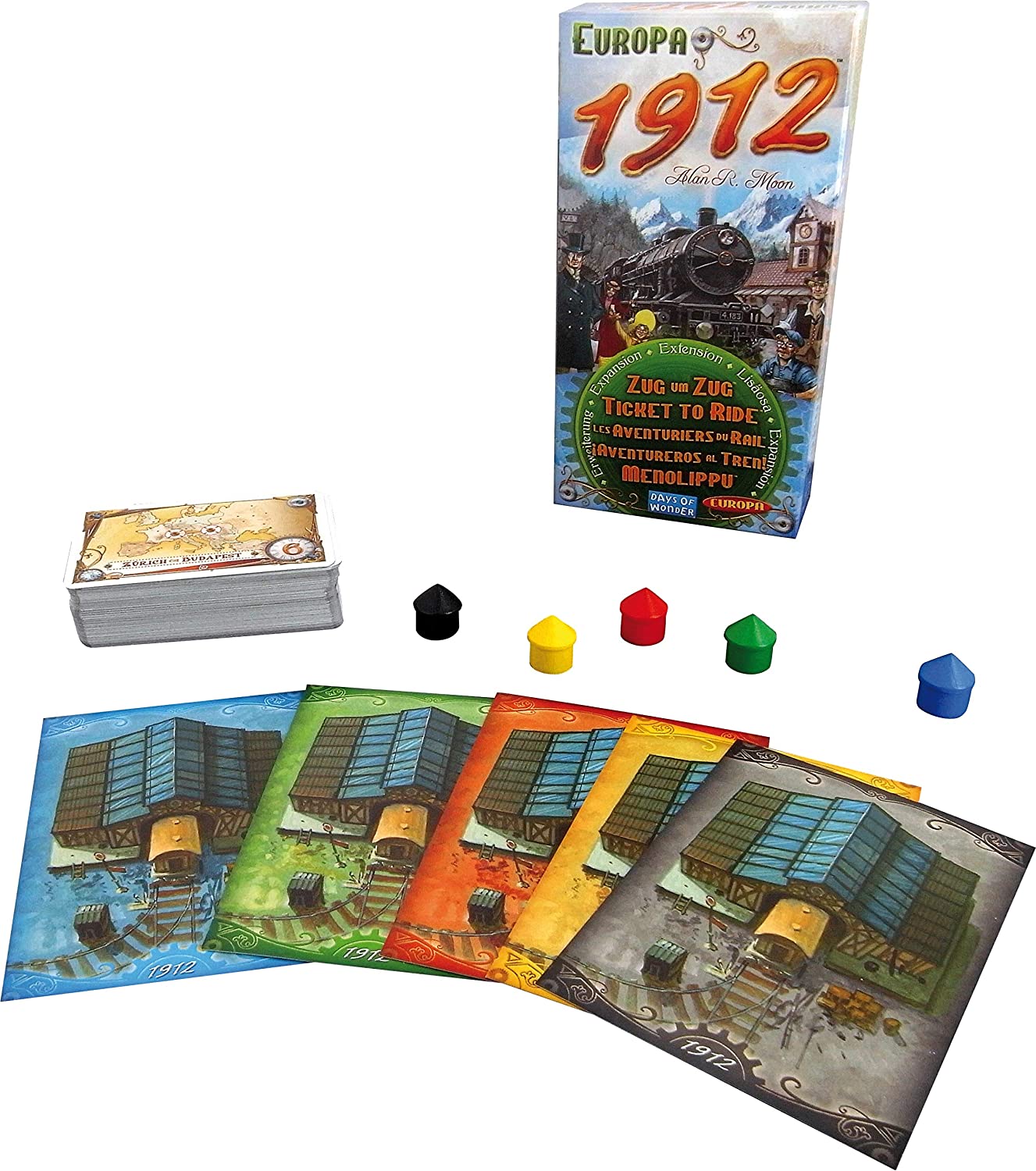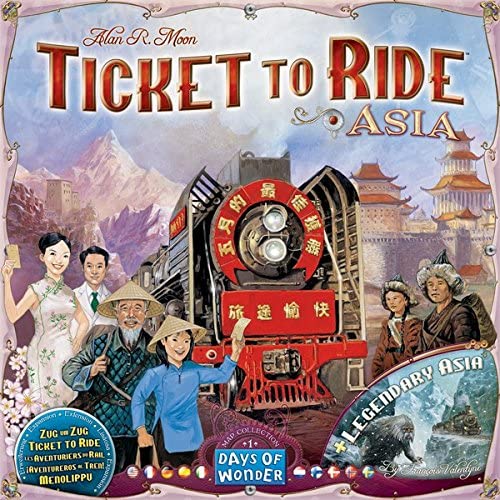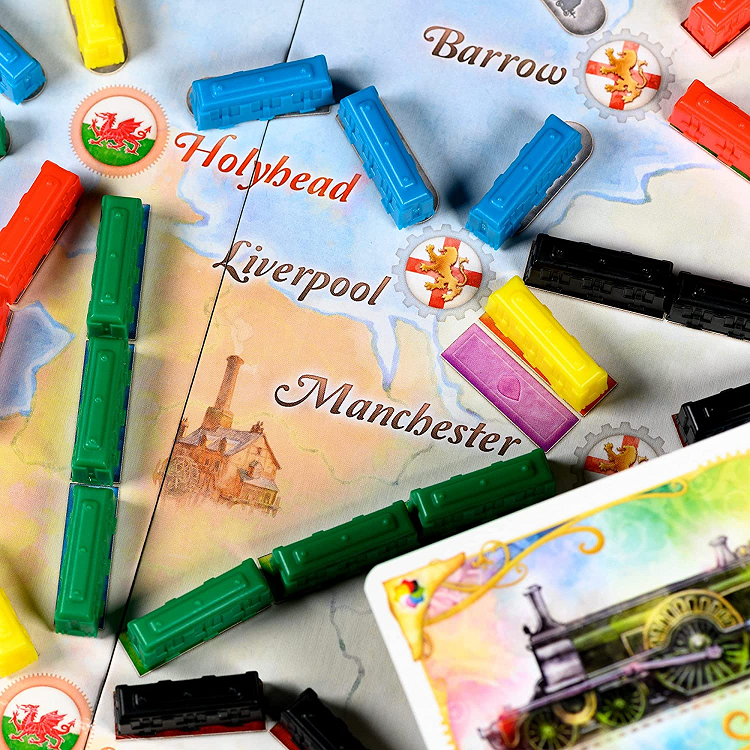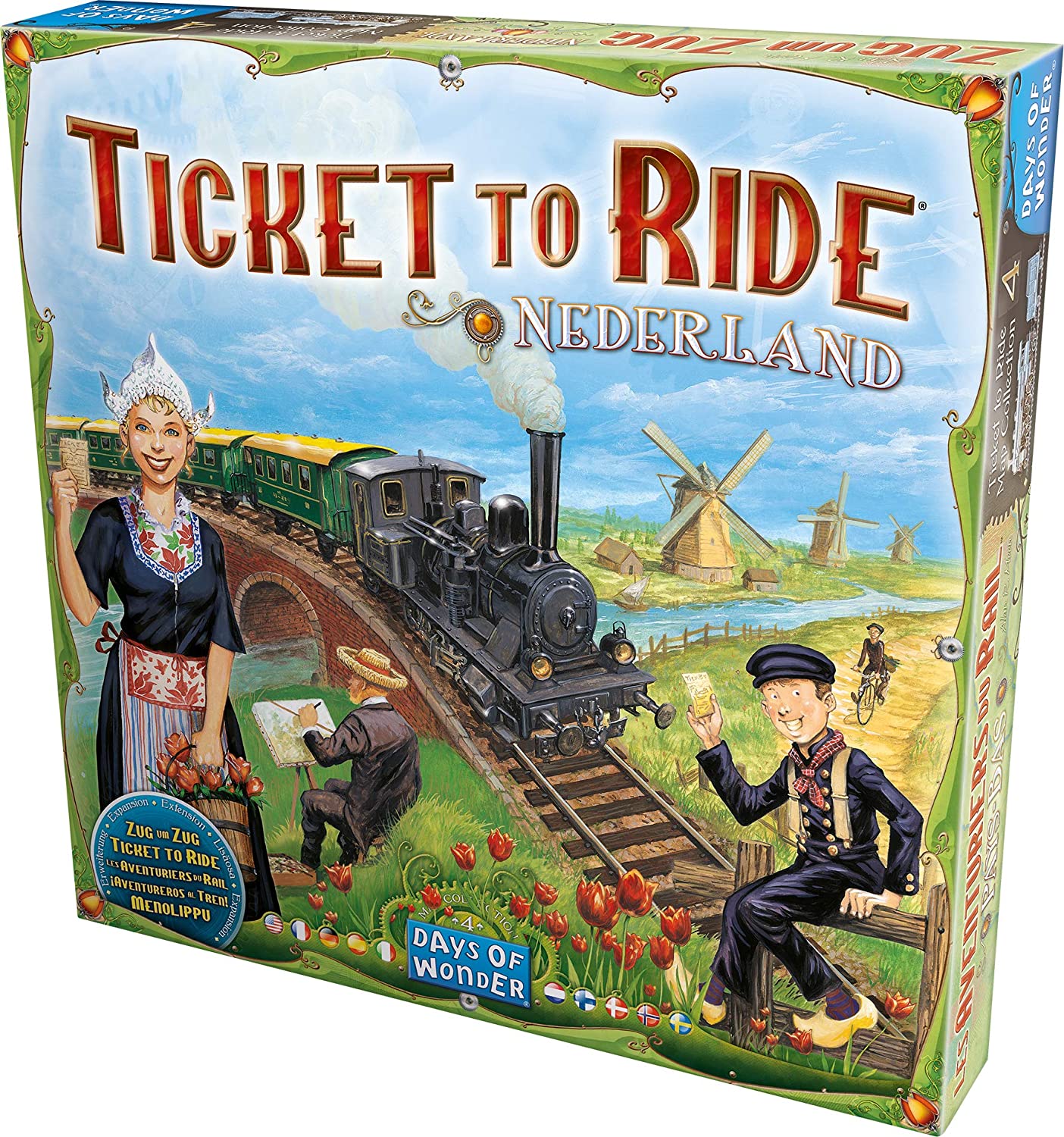Europe is a small continent but is diverse in its landscape. From snowy peaks to sunny oceans within a few hours of each other, you can see why it’s a popular area to travel by train.
It only makes sense that you would make a traveling game such as Ticket to Ride Europe that embodies all of these qualities.
Ticket to Ride Europe took the original game to a new level with tunnels and oceans that coordinate with the diversity of Europe’s land.
You can take short routes from Rome to London while passing through tunnels under mountains and taking ferries across oceans. Here is a complete overview of Ticket to Ride Europe to see exactly what I’m talking about.
Quick Overview of Ticket to Ride Europe
Players: 2-5
Time to Play: 30-60 minutes
Ticket to Ride Europe is another fun addition to the original with quite a spin on it. It comes with a new map, larger cards, and new elements that add complexity. With tunnels, ferries, and stations, many find this version of Ticket to Ride to be the best one out there.
What is Ticket to Ride Europe?
Pros
- Added complexity
- Larger playing cards
- Can play with up to 5 players
- It can be learned in less than 15 minutes
Cons
- It may not be suitable for younger kids
- It takes longer to play
About Ticket to Ride Europe
Ticket to Ride Europe was released in 2005, a year after the original Ticket to Ride. This version adds a new map with more complex routes. There are train routes, but there are also ferry routes and tunnel routes. Each of these route types adds a level of difficulty that the original Ticket to Ride does not have.
On top of new routes to take, you can also build stations to help you claim taken routes. Unlike the extra route options, this feature makes it easier to get to whatever destination you attempt to complete. However, if you do not use these stations, you have a chance to gain even more points.
Even though there are many new components to Ticket to Ride Europe, you still get the same feel as the original. The goal of receiving the most points is the same with a new way to get there. This new and improved version will make you love Ticket to Ride again.
What’s Included
- 225 Train Cars
- 110 Train Car Cards
- 46 Destination Ticket Cards
- 1 Scoring Card
- 1 Longest Path Bonus Card
- 15 Stations
- 5 Score Markers
- Board Map
How to Play Ticket to Ride Europe
Set-Up
Hand each player 45 matching train cars, a set of three train stations, and place a scoring marker on the start for each player. Deal four train cards to each player and place the remaining deck next to the board. Flip the top 5 cards and place them next to the deck in a line.
Next, separate the long route destination tickets from the rest. These are the destination tickets with blue backgrounds. Deal one to each player and place the remaining back in the box without showing anyone.
Shuffle the short destination tickets and hand three to each player. These are the destination tickets with plain backgrounds. Place the remaining destination tickets in a draw pile next to the board.
Each player must then choose which destination tickets they want to keep. You must possess at least two but can hold as many as you want. Any discarded cards must be thrown back into the box without showing any other players.
How to Win
To win the game, you must score the most amount points. Remember, any uncompleted destination tickets in your possession are worth negative points. There are four ways to score points, including:
- Claiming a route
- Completing a continuous path between two cities on your destination tickets
- Winning the European Express Bonus by completing the longest continuous path
- For each train station not used by the end of the game
On Your Turn
Choose the starting player and continue playing clockwise. Each player may do one of the following actions:
Draw Train Car Cards
There are nine different train car cards that coordinate with routes on the board map, including locomotives, purple, blue, orange, white, green, yellow, black, and red.
You may draw up to two train cards either from the deck or from the face-up cards on your turn. If you draw from the face-up cards, immediately replace the space and draw your second card.
You may not choose a second card if a locomotive card is selected from the face-up cards. However, if you draw a locomotive in a blind draw from the draw pile, you may choose a second card. If you flip a locomotive card to replace a face-up card, you may not choose that card as your second card.
Claim a Route
You can claim one route per turn. Claim a route by discarding the same colored cards as the desired route in the same amount as there are spaces.
You can fulfill gray routes with any matching set of colored train cars. You may also use locomotive cards as a wild in place of any colored cards you do not have.
Train cars are then placed on the claimed route. You must complete a whole route between two cities at once. Move your scoring marker around the outside border of the board map to the number of points earned.
To identify how many points you earn for your route, use the scoring table near the top of the board.
Draw Destination Tickets
Destination tickets list two cities where you must complete a continuous path of routes. The number on the card is the number of points you will receive or subtract, depending on whether you finish the track before the game ends. Destination tickets are kept secret until the end of the game.
During your turn, you may draw three destination tickets from the deck. You must keep at least one of these tickets but can keep all three.
Discarded tickets that you choose not to keep are put back on the bottom of the draw pile. If there are less than three destination tickets in the draw pile, you may draw the remaining tickets. Your chosen tickets must be kept until the end of the game and cannot be discarded with a later draw.
Build a Train Station
Train stations allow players to use a route that other players have already claimed. You can place a train station in any city that another player’s station hasn’t already claimed. There do not need to be any routes claimed that lead to that city to place a station.
You may place one station per turn by discarding one train card of any color for the first station. You must discard two train cards of the same color for your second station.
The third station can be placed by discarding three train cards of the same color. Locomotives can be used to replace any colored card you do not have.
If you use your station to complete a destination ticket, you must use that same route to meet any other tickets. You do not need to choose which route you are using until the end of the game. At the end of the game, any unused train stations are worth four points.
Ferries
Ferries are identified by gray spaces, with at least one of the spaces on the route having a locomotive icon. They are the routes that go over a body of water at some point.
To claim a ferry route, you must play the same amount of locomotive cards displayed on the route. The remaining cards can be whatever color train cards that match.
Tunnels
Tunnels are identified by the odd-shaped spaces that are outlined in black. To claim a tunnel, lay down the appropriate amount of train cards in the correct color.
Then flip the top three cards of the train car deck face up. If there are any matching cards, you must lay down additional cards of the same color in the drawn amount.
As with claiming any other route, you may use locomotive cards as wilds. That also means that if a locomotive is drawn in the three cards, you must match it with another colored card or locomotive. If you use all locomotives to claim a route, you only need to match the drawn locomotive cards.
If there are not enough cards in the draw deck to draw your three cards, you may only draw the remaining cards for this turn. You do not have to draw any cards to claim a route if the deck is empty. Also, if you do not have enough cards to match drawn cards or do not wish to play them, you lose your turn.
Locomotives
Locomotives are multicolored cards with black locomotives pictured on them. These cards act as wild cards, and you can play them in replacement of any colored card to help complete a route. You may use as many as you would like in a play and can even complete a whole route with only locomotives.
If at any point the five face-up cards in from the draw pile have three or more locomotives in it, you must discard the five cards and new cards placed out.
Drawing a locomotive from the five face-up cards forfeits your second draw. However, if you draw a locomotive in a blind draw from the pile, you may still choose your second card.
Double Routes
Some routes between cities have a double route with two pathways lying parallel to each other. Two players may claim these routes, but one player may not claim both routes.
Routes that go to two different cities and connect part of the way through to the same city are not double roots. In two and three-player games, players may only use one of the routes in a double route.
Ending the Game
Once a player has two or fewer train car pieces after their turn, every player gets one more turn, including that player. When everyone has finished their final turn, you add up your points.
Points from routes claimed should have been recorded throughout the game on the score marker around the border of the game board.
Flip over your destination tickets for all of the players to see. Add or subtract any finished or unfinished destination tickets to your score. Add four points to your score for each train station you did not use.
The European Express bonus (ten points) should also be awarded to the person with the longest continuous path.
The player with the most amount of points wins the game. If two players are tied, the person with the most amount of completed destination tickets is the winner. In the unlikely event that they are still tied, the player who used the least amount of stations wins.
Ticket to Ride Europe Expansions
Europa 1912
Pros
- 101 new destination tickets
- Three new ways to play
- New warehouses and depots
- It can be used to play with other Ticket to Ride game maps
Cons
- Ticket to Ride Europe or the original Ticket to Ride is required
This expansion pack was made for Ticket to Ride Europe. With new destination tickets that you can play in three new fun ways and new warehouses and depots, Europa 1912 adds unlimited fun to keep you enjoying Ticket to Ride Europe for a lifetime.
You can also use the warehouses and depots on any other gam map in the Ticket to Ride series.
Ticket to Ride India
Pros
- Two maps are included
- A nice in-between of the original and Europe
- More high paced
- Made for fewer players
Cons
- Not as complex as Ticket to Ride Europe
If Ticket to Ride Europe seems too much for you, you may like this simplified Ticket to Ride game map. This expansion has two different maps with different components that you will find in Ticket to Ride Europe.
The Switzerland map has the tunnels, and India has the ferries. It is excellent for those who think the original is too simple, but Europe is too complex. You must have either the original or Ticket to Ride Europe to play this version.
Ticket to Ride Asia
Pros
- Play in teams
- Two maps
- Play with up to six players
Cons
- This is an expansion pack and requires other pieces
In Ticket to Ride Asia, you can choose between two different Asian maps. One is made to play in teams of two, and the other is made for single players.
Your teammate can either help you complete routes and claim victory, or working together may make it more difficult. You must have the original Ticket to Ride or Ticket to Ride Europe to play this expansion map.
Ticket to Ride United Kingdom
Pros
- It has two maps (the United Kingdom and Pennsylvania)
- New Components to add difficulty
- More competitive and strategic
Cons
- Smaller maps
Ticket to Ride United Kingdom comes with two maps that are two very different games. The Pennsylvania map has the specific added component of stock shares, while the United Kingdom map requires technology cards to claim particular routes.
Both add new strategies that you can use during the game that give you hours more of gameplay.
Ticket to Ride Nederland
Pros
- The new toll bridge component
- New bonus based on tokens at the game’s end
- It can be played without bridge toll tokens
Cons
- Requires pieces from Ticket to Ride or Ticket to Ride Europe
Ticket to Ride Nederland gives you more real-world experience with money being involved. Nederland has many waterways that you must pass over and can only be completed by a toll bridge.
In this version, you pay tolls to take bridges, take out loans, and can steal tokens from other players. If you find these components too complex, you can play this map with standard Ticket to Ride rules.
FAQ’s
Question: What Countries are in Ticket to Ride Europe?
Answer: The countries in Ticket to Ride Europe are England, Spain, France, Italy, Switzerland, Germany, Belgium, Netherlands, Sweden, Denmark, The Russian Empire, Serbia, Romania, Bulgaria, the Turkish Empire, Austria, and Hungary.
The map is based on the Europe map from 1912, so it does not have European countries how they are at present.
Question: How Do You Play Ticket to Ride Europe?
Answer: The goal of Ticket to Ride Europe is to get the most amount of points. You do this by claiming routes, fulfilling destination tickets, creating the longest path, and keeping train stations. Once a person has two or fewer trains left, everyone gets one more turn, and you add up your points and bonuses.
Question: Is Ticket to Ride Europe Different than Ticket to Ride?
Answer: Yes. There are new components in Ticket to Ride Europe, such as tunnels, ferries, and stations. Many find this game to be more fun due to its added features, and it also has a new map and larger playing cards.
Question: Can You Play Ticket to Ride Europe with Original Rules?
Answer: Yes, you can. You would play all of the spaces as regular spaces and not use the stations. Everything else about Ticket to Ride Europe is the same as the original game. This may be an ideal playing method if you play with younger kids who may not understand the added components.
Question: How Long Does it Take to Play Ticket to Ride Europe?
Answer: The instructions state that playing takes 30-60 minutes. However, it can take much longer. Especially now that there is a possibility of losing turns and needing more cards to claim routes. This depends on how many players you have and how the game plays out.
Overall Impression of Ticket to Ride Europe
Between Ticket to Ride Europe and the original Ticket to Ride, I would have to say this one is my favorite. The original Ticket to Ride is excellent to start with and get the hang of the game, but it gets boring pretty quickly.
With all of the added components in Ticket to Ride Europe, there are more strategies you can use, more risk involved, and it is overall just a better map.
The cards that come with Ticket to Ride Europe are also more standard size than the original Ticket to Ride. I don’t know about you, but I’m not too fond of the small, half-sized cards, and they aren’t as comfortable to hold in your hands.
You can get full-sized cards for Ticket to Ride with the expansion pack “1910”. But why would you do that when you could get Ticket to Ride Europe? That is a better game anyway.
The only people I would not recommend Ticket to Ride Europe are people who want to play with children. The box says you can play Ticket to Ride Europe with kids as young as eight, but I feel that’s a little ambitious.
The added components to this game seem too complex for an eight-year-old, and I would say it’s made more for ages eleven or twelve and up. However, you could play this game with the original rules and ignore the new route rules.
Recommended reads:
- A Complete Overview of Ticket to Ride
- A Complete Overview of Ticket to Ride India
- A Complete Overview of Ticket to Ride New York
- Cards Against Humanity Expansions List - February 26, 2023
- Ticket to Ride Europe Guide - April 19, 2022
- A Complete Overview of Ticket to Ride - March 17, 2022


